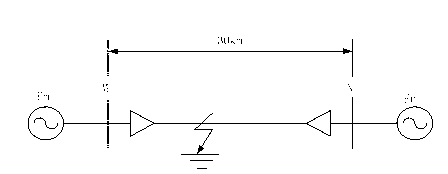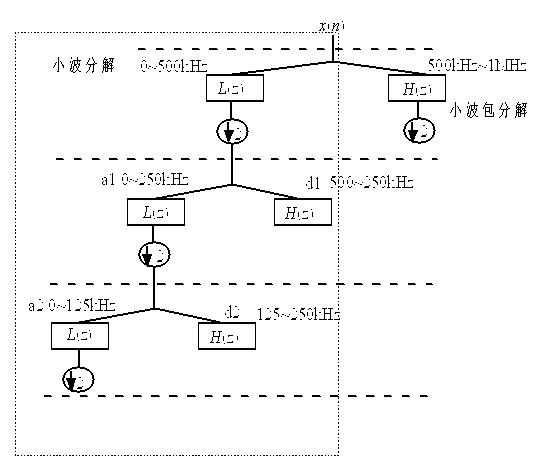Cable single-ended travelling wave distance measurement method using fault signature frequency bands and TT conversion
A technology of fault characteristics and distance measurement method, applied in the direction of fault location, etc., can solve problems such as error, dispersion, and inconsistency of attenuation degree of different frequency components, and achieve the effect of improving distance measurement accuracy and reducing error
- Summary
- Abstract
- Description
- Claims
- Application Information
AI Technical Summary
Problems solved by technology
Method used
Image
Examples
Embodiment 1
[0055] Example 1: Resistive failure.
[0056] 110kV cable line structure schematic and layout such as figure 1 As shown, the cable has a total length of 30km. The equivalent impedance of the M-end system is 1.67+j43.18W, and the N-end system impedance is 1.01+j44.92W. In order to remove the influence of the sound line on the identification of the faulty traveling wave head, the length of the sound line is taken as 100km; 2km, A phase ground fault occurred, and the transition resistance was 10Ω.
[0057] The first step is to decompose the current traveling wave with db10 orthogonal wavelet, if the maximum scale is 5, such as Figure 4 Shown.
[0058] The second step is to use correlation analysis to calculate the correlation coefficient between the initial traveling wave head and the reflected wave head of the fault point in each frequency band, and define the correlation coefficient The maximum, that is, the frequency band with the greatest similarity between the initial traveling...
Embodiment 2
[0063] Example 2: Arc fault.
[0064] A lot of practical experience shows that the dynamic characteristics of an arc can be simulated by the following differential expression, and an arc model is built. The measured arc characteristics are as Figure 8 , Picture 9 Shown. Figure 8 Is the arc voltage-current characteristic of the cable arc; Picture 9 Is the spectrum of cable arc voltage.
[0065]
[0066] (6)
[0067] (7)
[0068] In equations (6) and (7), Is the arc conductance that changes over time, It reflects the static characteristics of the arc, which can be interpreted as the arc conductance value when the arc current maintains a certain value for a long enough time under constant external conditions. i Is the absolute value of the arc current, It is the arc voltage per unit length of an arc.
[0069] The first step, if the A phase arc ground fault occurs 11km away from the M measuring end, use the db10 orthogonal w...
Embodiment 3
[0075] Example 3: Resistive failure.
[0076] 110kV cable line structure schematic and layout such as figure 1 Shown. The total length of the cable is 30km. The equivalent impedance of the M-end system is 1.67+j43.18W, and the N-end system impedance is 1.01+j44.92W. If the distance to the measuring terminal M is 19km, a phase A ground fault occurs, and the transition resistance is 10Ω.
[0077] The first step is to decompose the current traveling wave with db10 orthogonal wavelet, and the maximum scale is 5.
[0078] The second step is to use correlation analysis to calculate the correlation coefficient between the initial traveling wave head and the reflected wave head of the fault point in each frequency band, and define the correlation coefficient The maximum, that is, the frequency band with the greatest similarity between the initial traveling wave head and the reflected wave head of the fault point is the characteristic frequency band. After calculation, the correlation co...
PUM
| Property | Measurement | Unit |
|---|---|---|
| Transition resistance | aaaaa | aaaaa |
Abstract
Description
Claims
Application Information
 Login to View More
Login to View More - Generate Ideas
- Intellectual Property
- Life Sciences
- Materials
- Tech Scout
- Unparalleled Data Quality
- Higher Quality Content
- 60% Fewer Hallucinations
Browse by: Latest US Patents, China's latest patents, Technical Efficacy Thesaurus, Application Domain, Technology Topic, Popular Technical Reports.
© 2025 PatSnap. All rights reserved.Legal|Privacy policy|Modern Slavery Act Transparency Statement|Sitemap|About US| Contact US: help@patsnap.com



